Goblin Fashion and Sexy Drug Gloves: On Clothing as Worldbuilding in The Inverted Spire
Hello, dear readers, and welcome to another lore-heavy dev log!
This time, we’ll be diving into the details and origins of New Order fashion~
But before we get too deep, I wanted to address that yes, there are many worldbuilding quirks in this story that are inspired by my own background. The Inverted Spire has a running theme around cultural upheaval and transformation due to seemingly indomitable, hostile and exploitative external pressures.
Much of the character's experiences revolve around how those massive shifts become personal. But rather than rely too heavily on the specificity of my own family and mixed cultural history, I wanted to reshape them into something bigger than myself.
It’s just one way to meet those pressures on my own terms!
So I’ve written this log with the intention to avoid giving a history lesson on any real-world parallels. It’s my goal, in building the goblin world, to describe a culture not directly comparable to any named group of humans in our reality.
That doesn't mean that I don’t welcome players drawing those real-world parallels themselves (especially if you feel that something is intimately relatable). But if you find yourself squinting to figure out what goblins ‘really are’ (throwing this one in for those of us used to being asked “so where are you really from?”), don't worry—that’s kind of the point.
And with that out of the way, let’s start with one of the goblin world’s most visible fashion statements:

Headwear

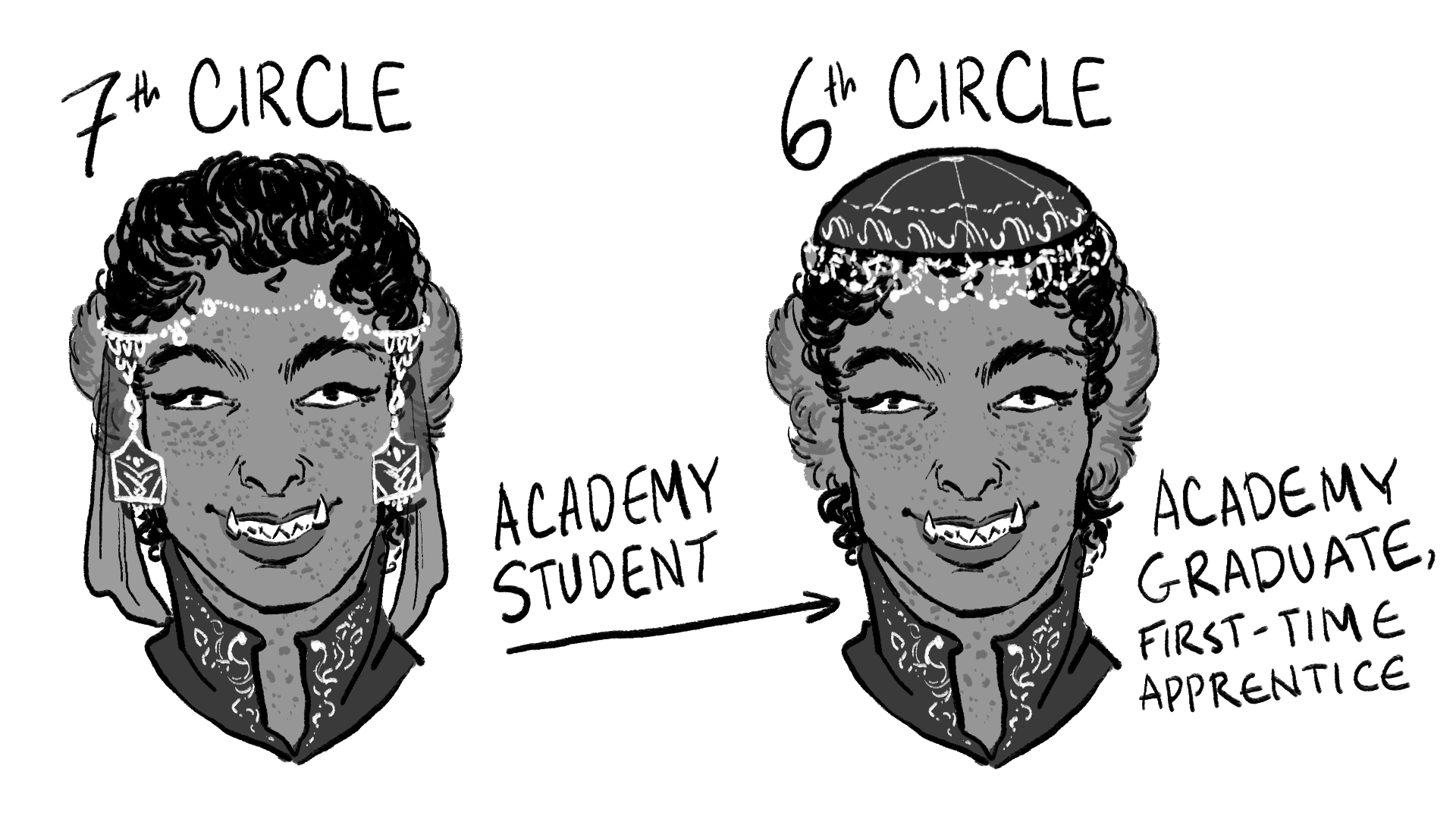
New Order citizens wear a range of elaborate headdresses that reflect their Guild rank.
These are items for everyday wear. They aren’t made from rare gemstones or soft alloys. Common materials for their construction include beads of clay, quartz and coloured glass, and thin frames of silver-plated iron, backed with felt for comfort.
While some are more decorative than anything, others (especially in the lower ranks) also serve a practical purpose, helping to weigh headscarves down in the wind, and otherwise protect their wearer from the elements. They often come in a set with matching clasps and buckles that can be attached to a citizen's robes in order to complete the look.
The making of headdresses, like many other facets of goblin fashion, involves a lot of delicate metallurgy. This is tied to the subterranean origins of the goblins themselves. Some of the more ornamented headdresses even resemble Old Order martial attire. A comparably cheap, gaudy replica of the kind of thing historical Guildmasters wore into battle.
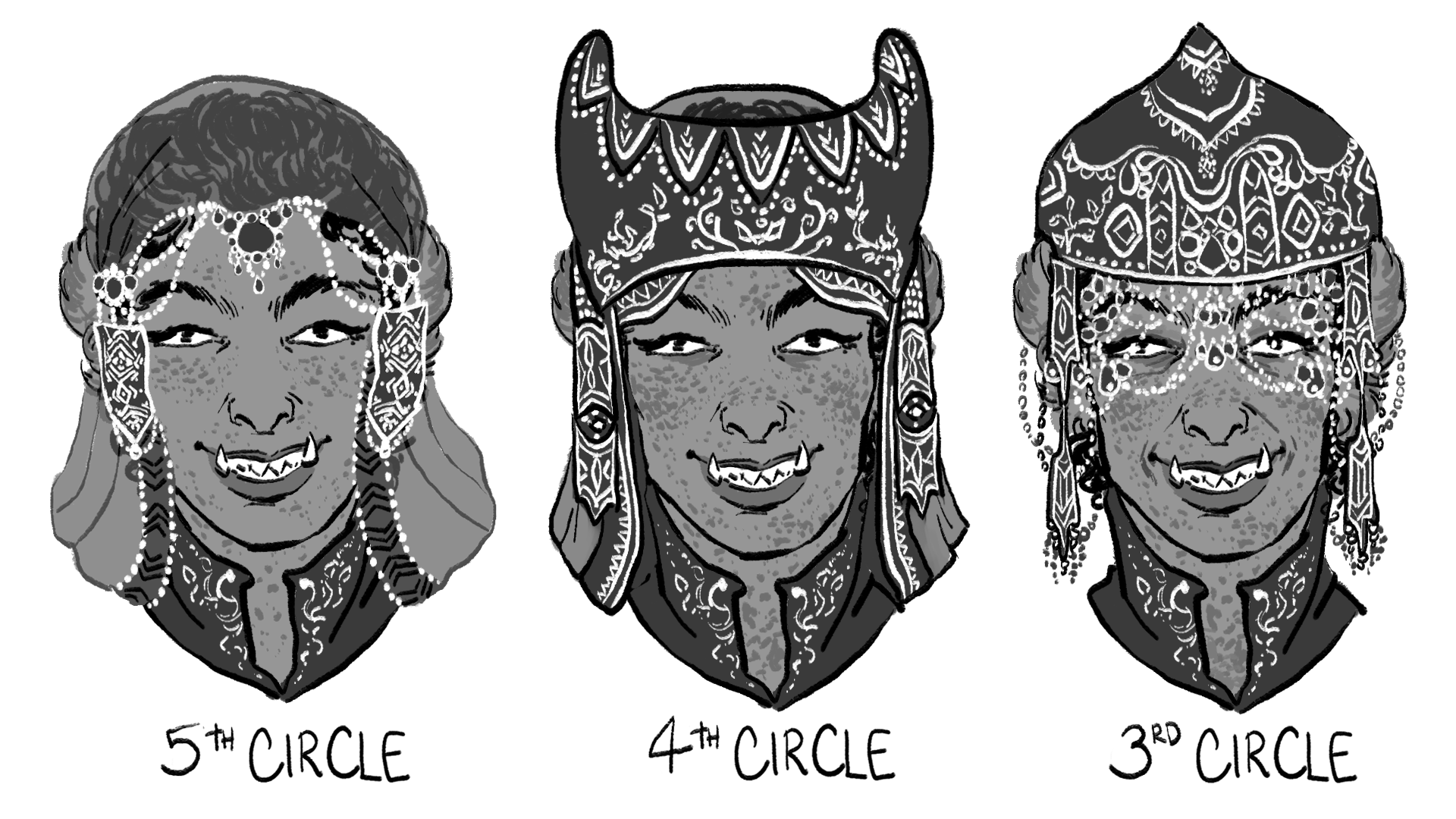
Goblins situated at or below the Third Circle purchase their headdresses at market.
Because the New Order economy is fully centralized, this market isn’t made up of competing merchants. Instead, Artificers trained into specialized crafting positions create individual pieces based on a set of designs and materials cleared by the Council for the year ahead. Even the total number of pieces to be produced for the year (by tiers of complexity and corresponding prices) are decided ahead of time.
Lower-ranking citizens pay for the headdresses with their leisure dispensations, which vary by Circle. While there is no explicit Equation protocol about wearing designs beyond the range typically associated with your Circle (so long as you don't try to imitate a Guildmaster or Bureau Agent), there is a social taboo against the practice.
Of course, most goblins can’t really afford the ornamentation worn by their superiors anyway, making it a hard taboo to break.
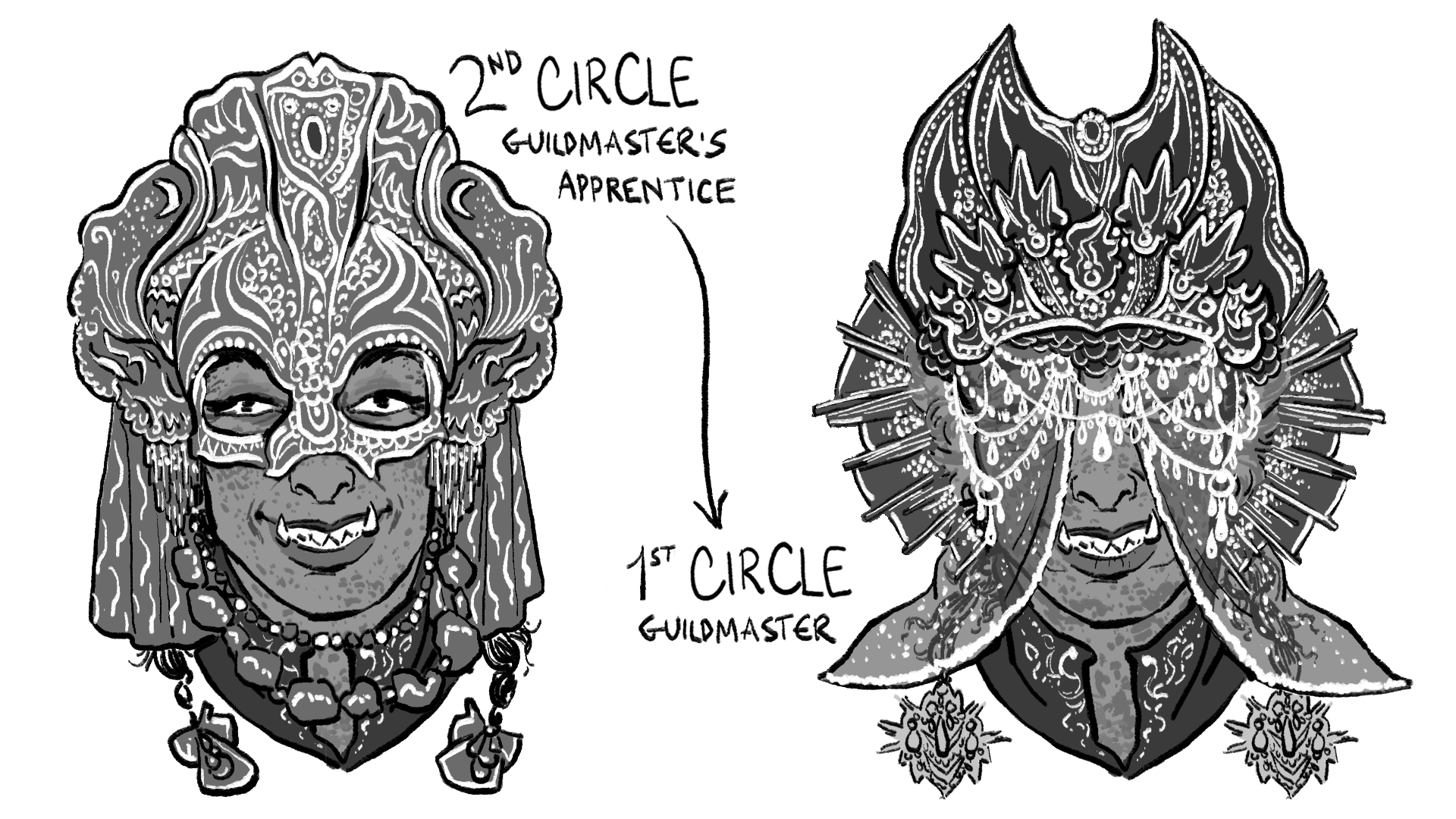
Citizens who have ascended all the way to the First and Second Circles have their headwear paid for directly by the Council, and crafted on commission by a small set of Council-approved artisans.
Imposing as they may seem, the headdresses of New Order Guildmasters don't even come close to approaching the outlandish extravagance of their ancestors. There are, after all, protocols under the Equation now to protect the makers from endangering their lives to obtain rare gemstones, or succumbing to toxin exposure after long hours spent forging impossibly intricate patterns.
Under New Order all are equal, aren't they?
But the more humble designs made for contemporary Guildmasters are still meant to communicate something about the goblin who wears them. They employ carved symbols of character traits and ambitions. Some are more explicitly obvious to the untrained observer, while others are a secret language between the commissioner and their maker.
Not that anything is truly secret under New Order.
Perhaps not even that.
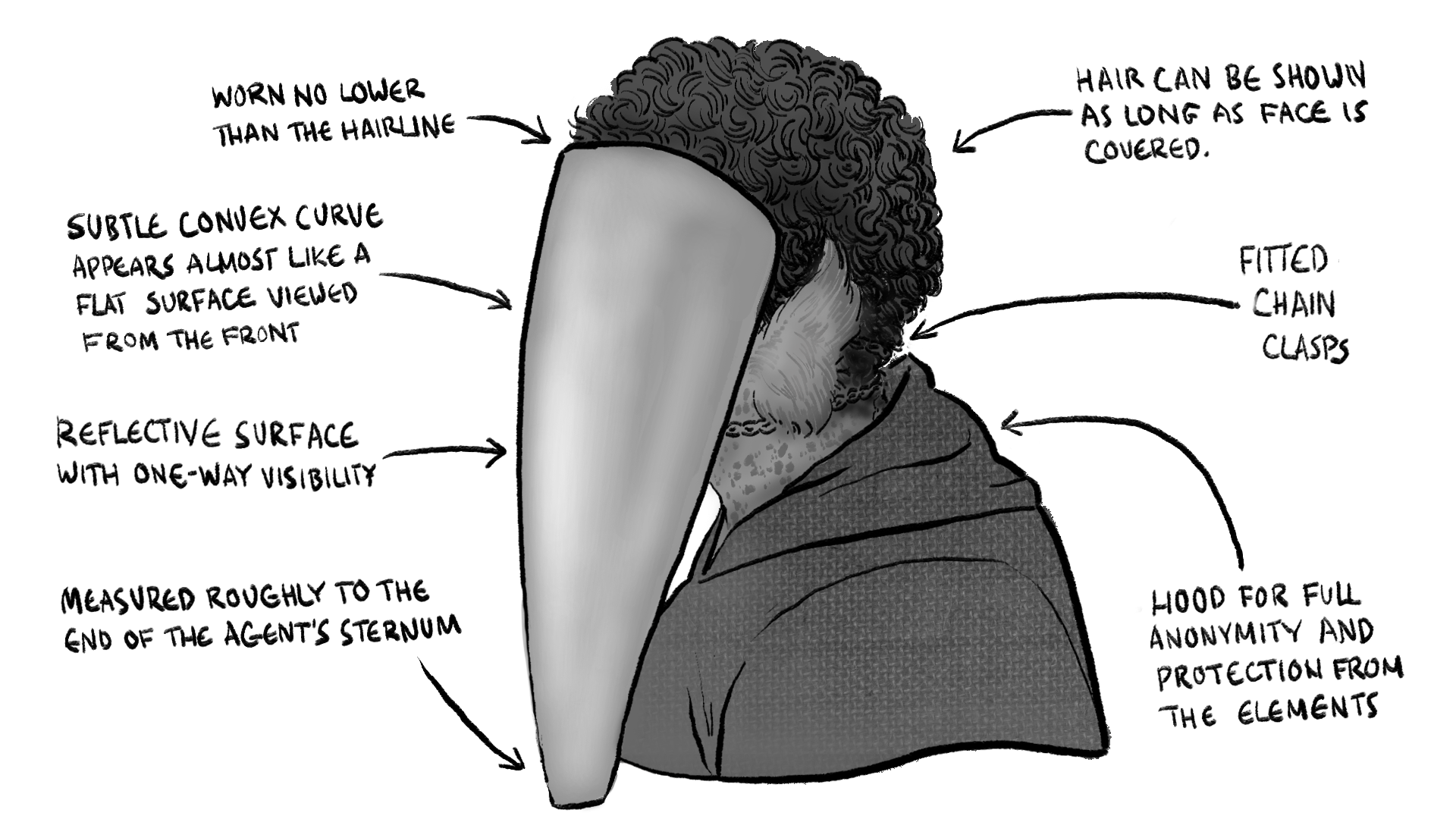
The oblong reflective mask is a type of headwear restricted exclusively to Bureau Agents. It is both a practical tool for anonymity on the job, and a symbol of their status as Keepers of Order (answering, in theory, directly to the Equation itself).
The mask is part of a full-body work uniform designed to be generic and forgettable. It represents a denial of self, rank, Guild affiliation and personal attachments when it comes to the Bureau Agent’s work.
Its plain, mirror-like surface also serves the purpose of forcing onlookers to confront themselves when approaching it.
Are you living an Orderly life, citizen?

Gloves


Goblins naturally grow claws. As children, they tend to get them clipped by long-suffering elders. But your average adult goblin wears their claws long and sharp. This makes gloves one of many adornments that distinguish academy students from first-time graduates eager to be perceived as capable.
Strong claws are also considered an attractive feature. They represent youth and good health, so goblins who exaggerate them with claw-tipped gloves are usually aware that their choices can be construed as seductive.
The typical glove is comprised of carved, pointed silver plates attached by moving hinges, hanging chains, and patterned fabric.
Guildmasters and manual labourers alike wear something more akin to gauntlets. These are comprised only of gleaming, segmented metal, reminiscent of an insect carapace. Unlike gloves, gauntlets also tend to cover the wearer's entire forearm. They are fully articulated, and designed with the intention of being easily usable in the performance of daily tasks.
In the higher Circles, gauntlets serve a decorative purpose, but are also calculated to look brutal and imposing. Similar to First Circle headdresses, their appearance is descended from Old Order military gear. Inlaid gemstones and bands of embossed bronze are not an uncommon addition.
For the labourers in lower Circles (particularly those involved in mining, construction and excavation of Old Order monuments), they are built to serve a practical purpose only. Their priorities are hardiness and mobility.

Robes

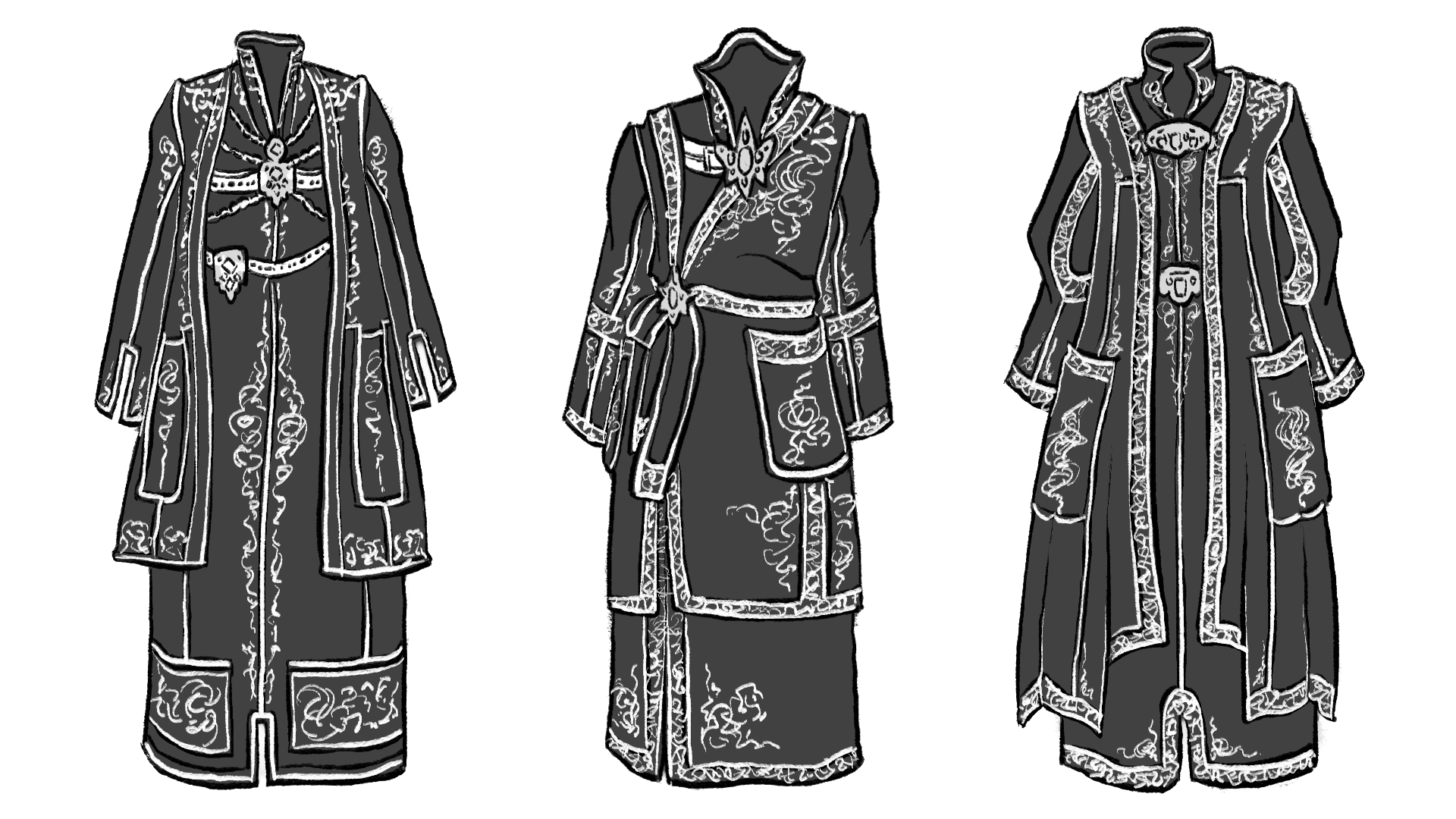
Goblins love dramatic, floor-length robes with extravagantly detailed embroidery.
Stylized vines, animals, Guild emblems, and artistic variations on the emblem of New Order itself are popular motifs.
There are certain restricted designs as well.
Embroidered trees and large floral motifs are associated with burial. They are typically only worn to Hortulan groves for the ritual planting of dead goblins. Citizens who belong to the Hortulan Guild are the only ones who wear these kinds of designs on a day-to-day basis.
A single reptilian eye, known colloquially as “the eye of Veles,” was a taboo symbol under Old Order, and is effectively forbidden under New Order. Similar shapes are considered equally suspect, even in their abstracted form.
Fur mantles are a callback to the hunter origins of goblins before the age of casting. Under New Order, the appropriate pelts are difficult to come by. This means they are typically worn only by higher Circle citizens as a symbol of status.
Other common stylistic features include high collars and ornamented metal clasps.
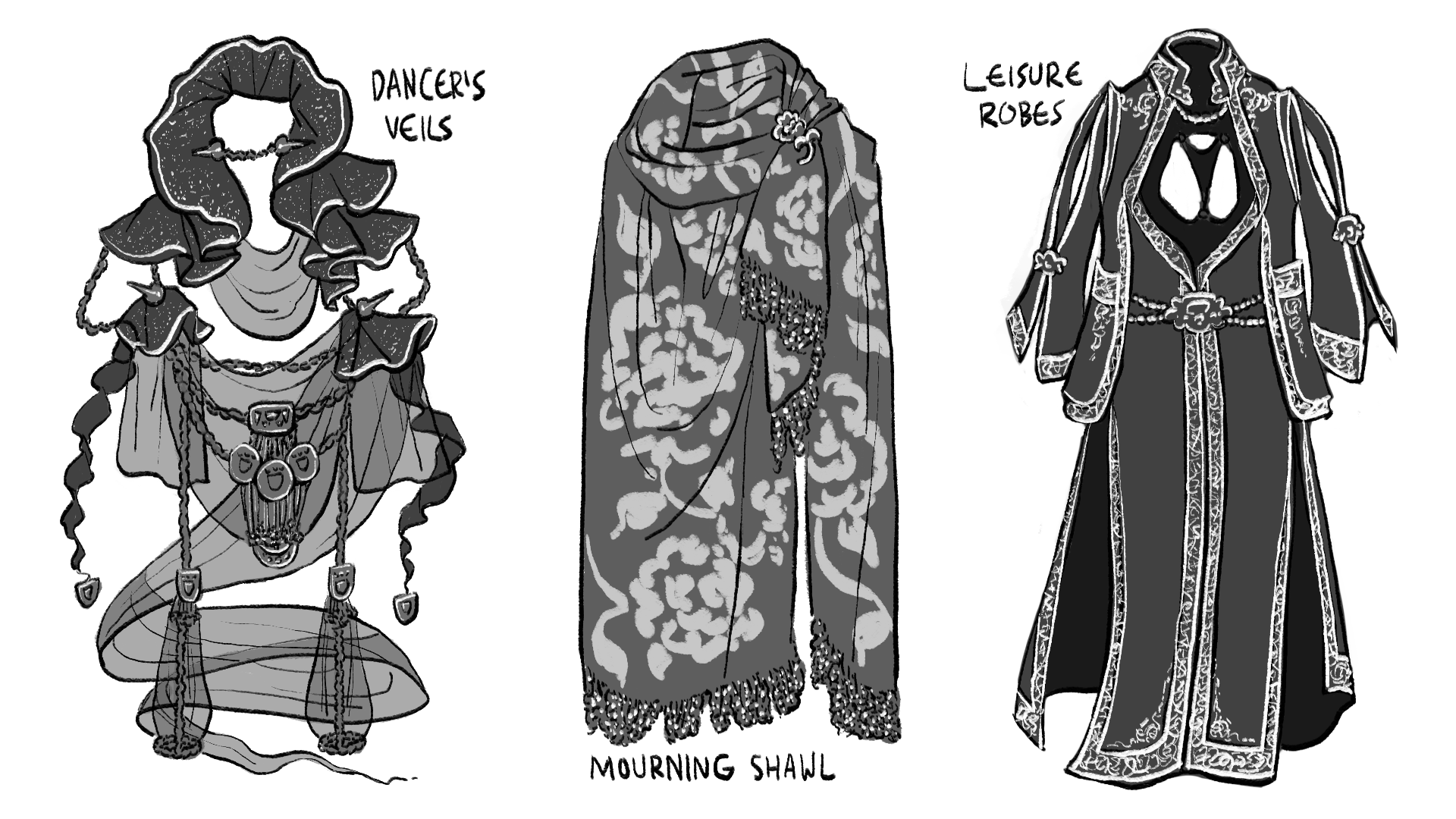
A goblin who isn’t afraid to draw attention will occasionally open their collar and wear it low to bare their spotted chest. Keyhole collars and open sides are likewise popular for a night out, but might receive a little more side eye on the clock.
While they have no taboo against multiple partners, New Order goblins do tend to be sensitive to the idea of peers using sex appeal to get ahead in their Guild. It’s not uncommon to hear that accusation levelled at young goblins who seem to be climbing a little too high too fast.
Dance had a special ritual significance under the religious authority of Old Order. It persists in New Order as a form of secular entertainment. Registered dancers wear veils adapted from the adornments of their ancestors. They would traditionally pass on these veils to their selected next-of-kin, thus cementing the legacy of their bloodline.
Of course, under New Order, legacy is forbidden as part of the anti-nepotism protocols. But some Old Believers still manage to get their way.
Both Council wards (citizens whose Equation scores have fallen below the threshold of acceptability) and Bureau Agents wear nondescript Council-issue burlap. The former tend to be a poorly-fitted rush job, while the latter are tailored for mobility and some limited degree of comfort.

Footwear

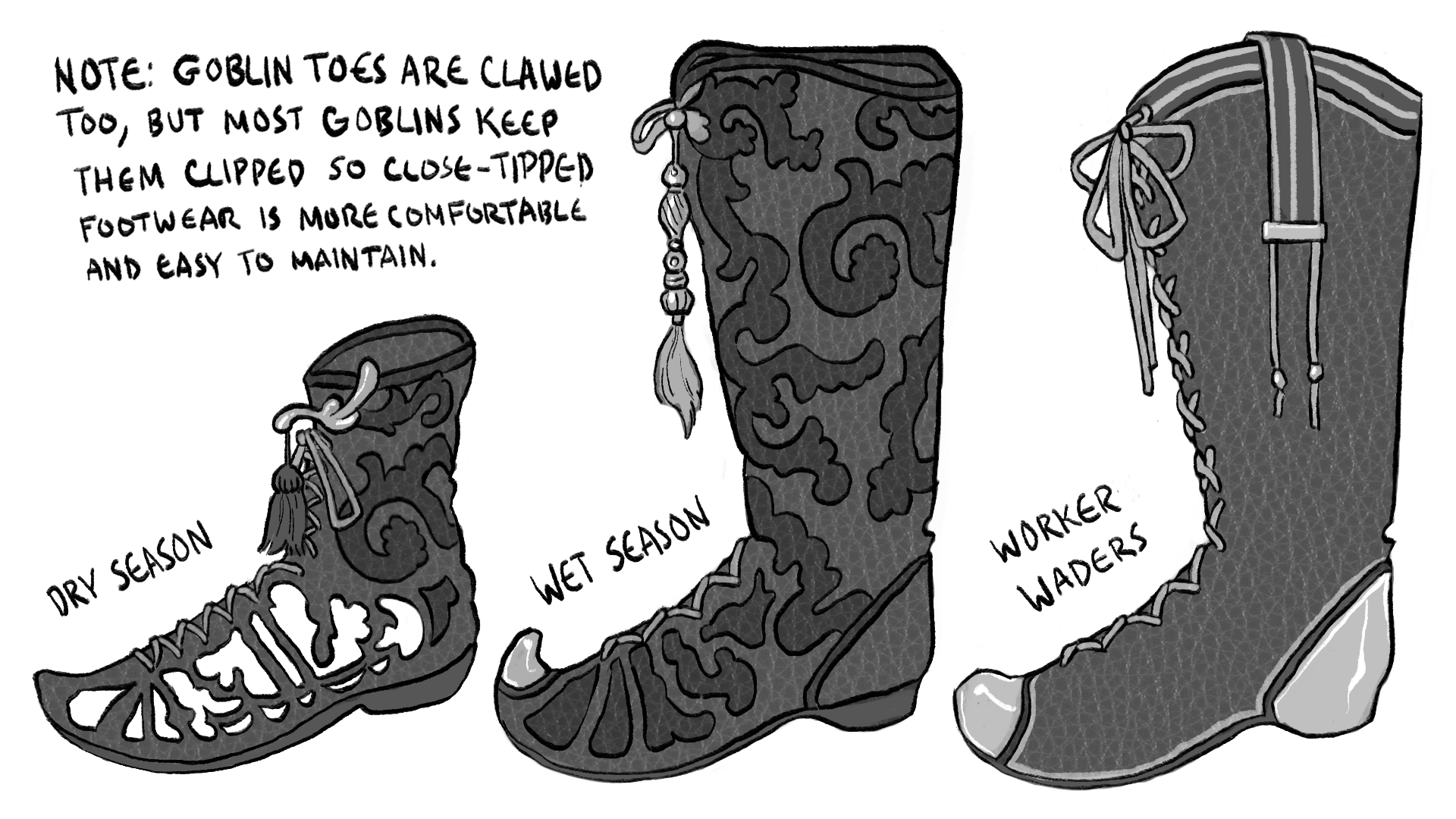
Because goblin robes are usually long enough to conceal the feet, and the average citizen is not equipped with a travel exemption to walk long distances, footwear tends to be fairly simple.
During the warm, dry season, goblins wear caligas made from tanned leather. They are occasionally decorated with beaded ornaments.
Cold and wet weather call for upwards-curving boots of similar make and build. Citizens working manual labour jobs may wear the latter kind of footwear all year round. Bureau Agents in particular wear tall wading boots in all forms of weather.

Enchantments

Contemporary folklore and hearsay suggests there used to be many kinds of enchanted garments under Old Order. The practice of enchanting clothing is discouraged under New Order, except when it comes to a recent Graviturge innovation: Council-issue carrying bags with temporary extradimensional space.
This is in part because of the way clothing enchantments were historically used. Through the collaboration of the Hortulan and Fleshcarver Guilds, 'enchanted clothing' was effectively clothing sewn with synthetic fibers that were said to have an effect on goblin bodies through direct contact with the skin.
There were two main reasons this kind of clothing was commissioned:
1—Making the wearer radiate an aura of charisma, or more precisely, sex appeal.
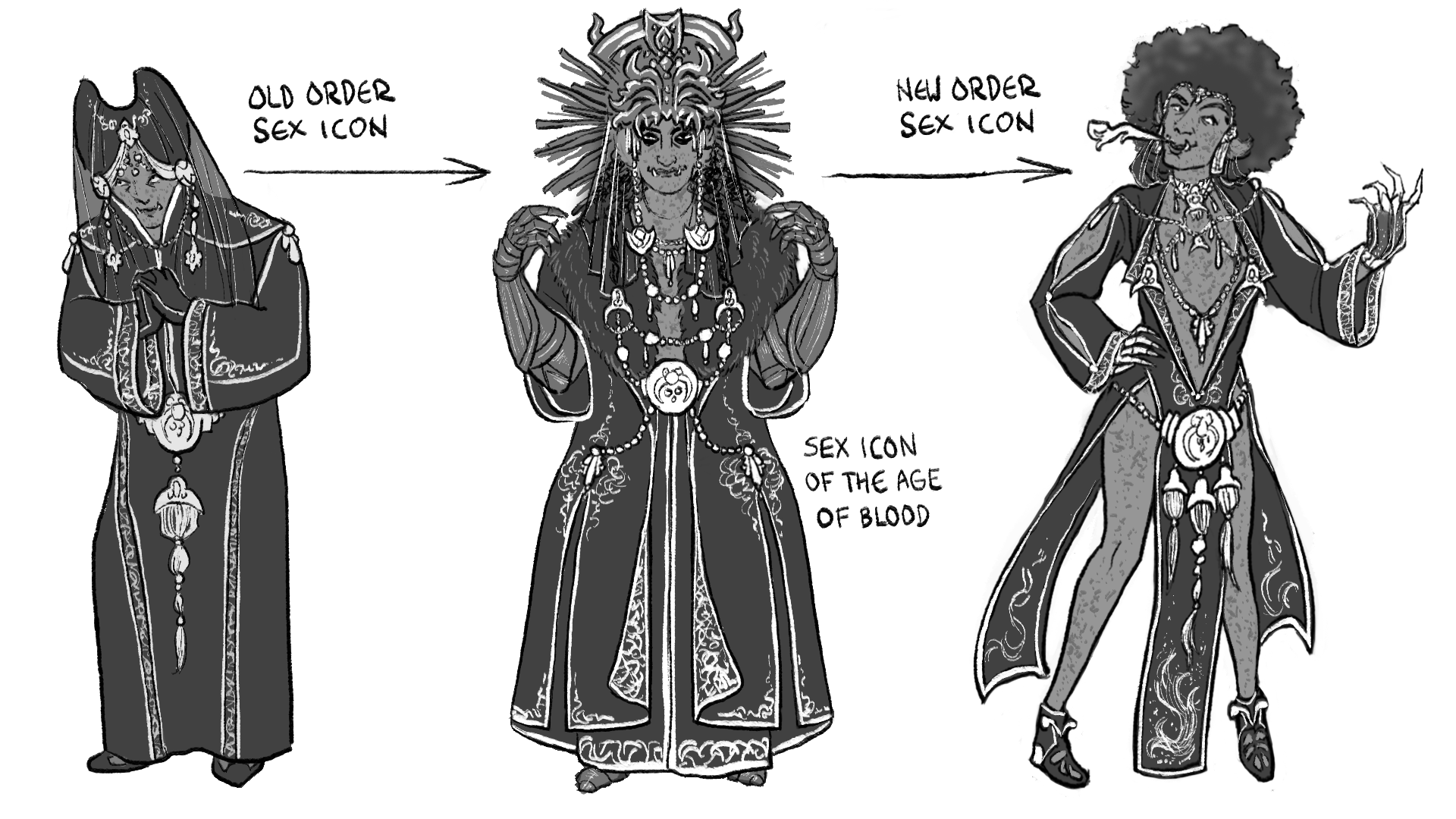
Old Order had a particularly complex series of associations with showing skin due to the religious connotations of blood and flesh. There used to be a widespread belief that a goblin’s casting potential was directly correlated with a quantifiable amount of “the spirit of Veles in their blood.”
Guildmasters were known to consume rivals and subordinates alike in an effort to become more powerful mages. Under the Old Order faith, their hunger was believed to be inherent, and a lower Circle goblin showing “a little too much skin” might be described as “asking to be eaten.”
This made robes that were at once sexy and concealing a desirable commodity.
Most New Order goblins perceive these attitudes as superstitious and archaic. In their world, it is usually Guildmasters who dress in the most concealing garments, because a higher rank is associated with greater access to privacy. But that never stopped anyone from wanting to embroider some black market threads into their robes.
Equation protocols condemn such practices as not being particularly aligned with New Order values, which promote total meritocracy on the basis of demonstrated ability and commitment (at least in theory).
It’s not—strictly illegal though.
2—Distorting the wearer’s perception (aka. tripping balls).
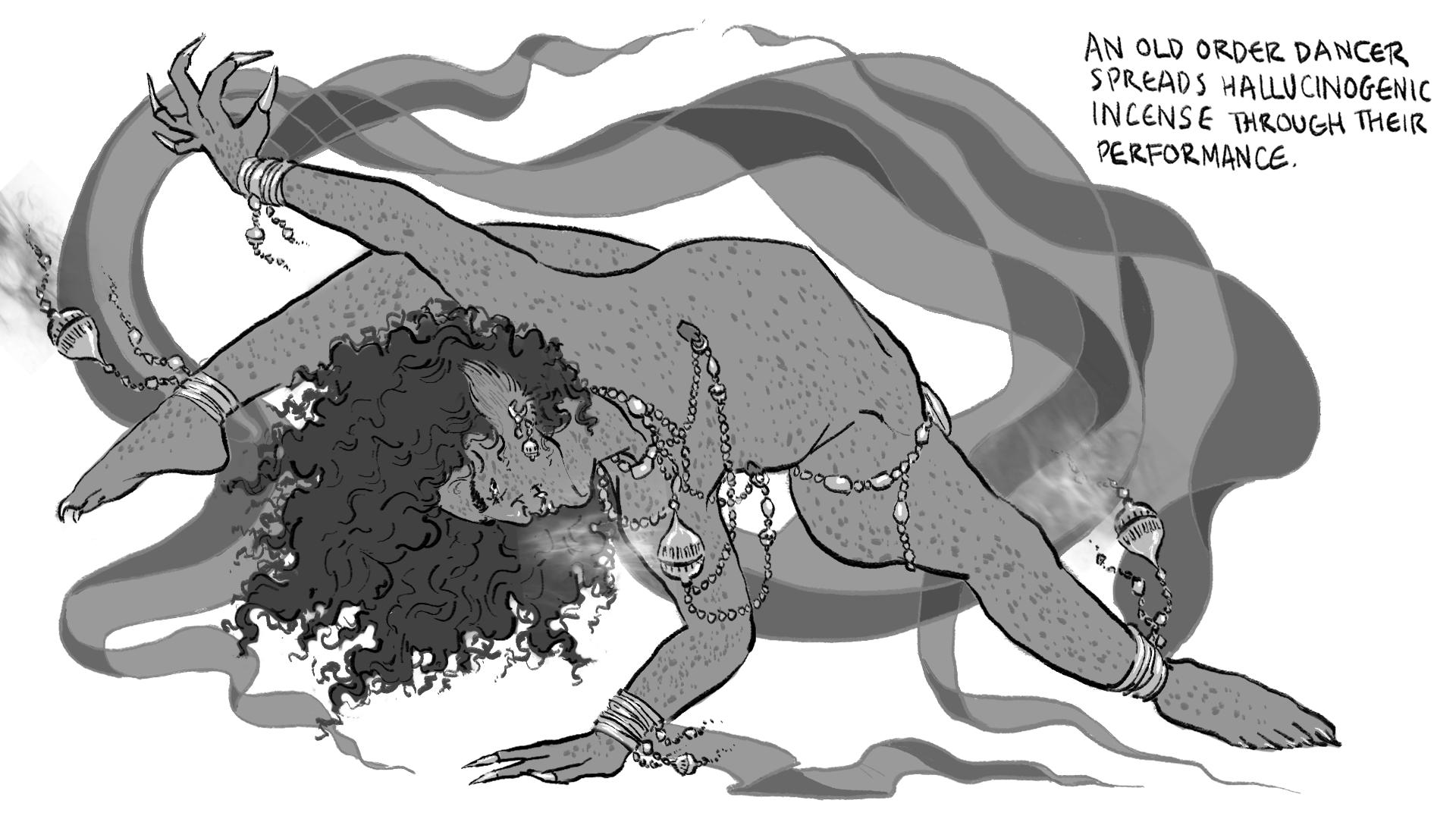
Fumes with hallucinogenic effects ranging from mild to reality-melting once played a major role in Old Order religious rites.
Mentalist-Prophets would use the heavier variety to induce visions. This would supposedly help them answer difficult questions about building a future for goblinkind.
Priests and sacred dancers used milder variants as mood-setters during community celebrations. Both employed incense burners for the purpose, with the dancer actually wearing , holding, or otherwise incorporating them into the act itself.
Under Old Order, priests and sacred dancers were protected classes. Priests were predominantly Mentalists, with some rare exceptions, but dancers came from all manner of magical disciplines, which occasionally played a part in their performance. The old faith taboo against showing skin meant that their barely-adorned nudity and translucent veils were a strong contributor to what made their weaving, jerking, borderline contortionist routines so entrancing.
They were meant to be seen and desired, but not eaten.
During the Age of Blood, when the Mentalist Guild was decimated and the central faith suffered a massive schism, the priest class was all but destroyed. Dancers had to retreat to their own Guilds for protection. This made the variety of sacred choreographies grow more diverse, but it also placed the dancers (who were frequently under threat already) in a far more dangerous position.
Many dancers survived by betraying old faith secrets to their respective Guilds. The preparation of hallucinogens was among them.
As part of a broader shift from sacred to secular, Guildmasters were eager to obtain the tools and entertainments once reserved for Mentalist-Prophets, and adapt them to their own purposes. One of the forms this took was clothing made from ‘enchanted’ fabrics that only produced the desired effects on contact.
(I bet you were wondering when sexy drug gloves would come into this)
Being easy to remove, and thus put an end to the experience at any time, gave these wearable novelties a significant advantage over other forms of drug use. Now it was not only Mentalists who could indulge in visionary journeys! Anybody could sit down for a conversation ‘with the Veles in their blood.’
(Yes, now I want sexy drug gloves too)
Like many magical innovations developed in the Age of Blood, psychedelic fabrics were eventually banned under Equation protocols. Among the many herbs known to produce mind-altering effects in goblins, only Mugwort and Wakeroot were considered to align with the values of New Order. The rest were scrubbed from public knowledge.
But hey, if you ask the right Hortulan, who knows what you might learn~

Accessories

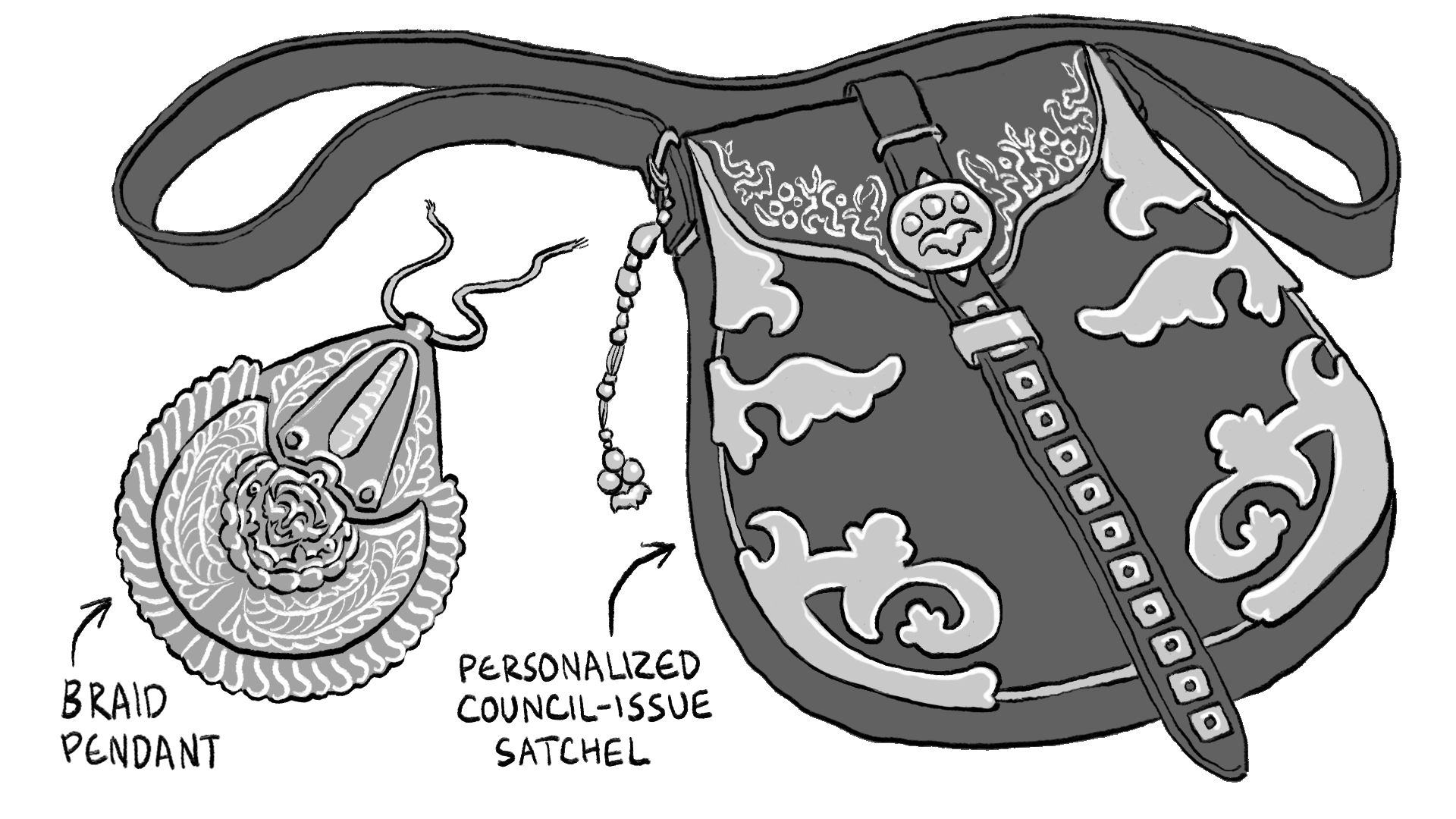
After donning their robes, gloves and headdress, the average goblin's daily wear is seldom complimented by additional jewelry.
Piercings, especially of the ears, were more common under Old Order, where they carried religious significance. The only citizens who still pierce their ears under New Order are caravaneers or registered entertainers, for whom the practice usually holds a more private, secular importance.
Goblins wearing robes that reveal their bare chest and legs may compliment their choices with heavy pendants, beaded choker-necklaces and matching anklets. This is most certainly not a daily look, unless you happen to be a professional dancer. But even on their off-hours, a citizen who makes the deliberate choice to dress like this often would be perceived as eccentric. A dangerous adjective to have attached to your name under New Order.
For goblins who grow their hair long (not an easy style to maintain in a world where most citizens only have access to overcrowded communal baths), beaded hair wraps are not a rare sight. Side braids and top knots are another frequent compromise. Those who are more industrious and have a lot of hair to spare may attach pendants to the ends of their braids, weighing them down and preventing them from becoming frayed or undone by the wind.
Goblins in bureaucratic and manual labour positions tend to have Council-issue carry bags, which they may choose to decorate with beadwork or embroidery at their leisure. Other citizens tend not to require them, since the deep pockets of an average robe are more than sufficient to carry citizenship paperwork, Bureau journals and leisure dispensation tokens. Even students usually make do without carry bags, because the majority of their books and supplies are kept to the academy itself.

Pipes

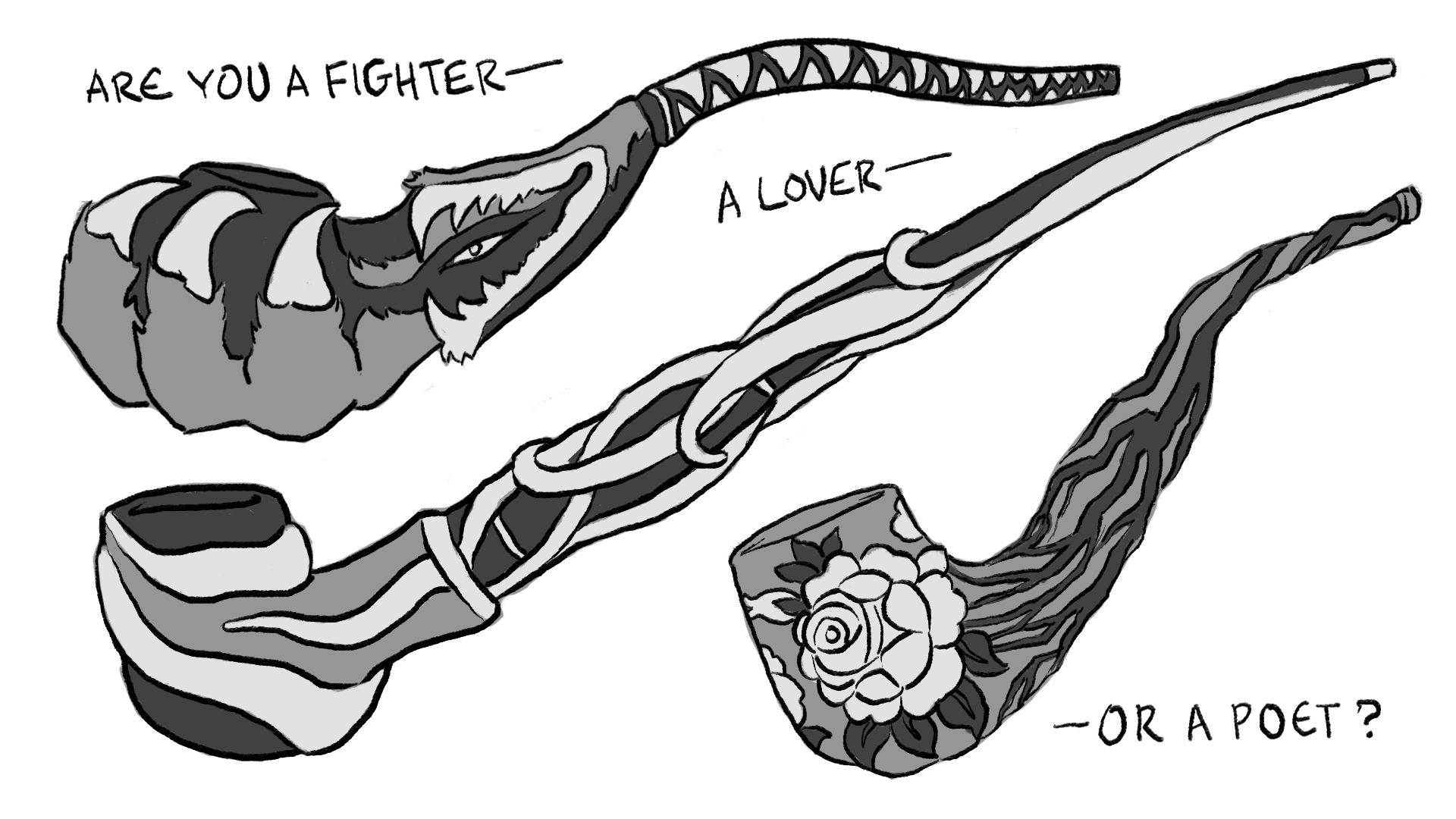
There are many dedicated Wakeroot and Mugwort smokers among the New Order population. The former is a herb easily obtained by any savvy caravaneer on the roadside, while the latter is mass-produced and rationed by order of the Council itself.
Smoking is, in fact, such a common pastime in New Order, that lunchtimes and gaps between work shifts are colloquially described as smoke breaks.
Pipes aren’t the only way of taking part, but they are the sign of an especially enthusiastic smoker. They also aren’t as heavily regulated as most New Order commodities. It’s fairly easy to obtain the materials and tools to carve your own pipe. Artificers in particular are known to make a killing in black market barter on handmade creations with beautiful craftsmanship.
When it comes to smoking pipes, popular motifs tend to be on the edgy side. Claws and jaws for the inner hunter. Smooth, sultry curves that make the whole thing look suspiciously like you-know-what for the compulsively seductive. Prickly branches and death grove flowers, if you’re the type who likes puffing on mugwort while staring off into the distance and contemplating your own mortality.

That's all for now!
Are you left with even more questions about goblin fashion, or the way New Order works in general? Then don't hesitate to comment below! There's a good chance we have an answer. And if the answer involves giving away too many spoilers about the mystery at the heart of the Inverted Spire, don't worry—because we're also very adept at giving answers that are at once informative and frustratingly obtuse ; )
Please bear with us as we continue to work towards out next update, which is presently well on its way to including all of the promised features in our last dev log (You can check back on those here).
With any luck, our next dev log may even feature some sneak previews at the storyboard for a coming trailer!
See you again very soon, dear reader~
Get The Inverted Spire
The Inverted Spire
Goblin mages dungeoncrawl to redemption.
| Status | In development |
| Authors | N. A. Melamed, feardeer, Mickey Hoz |
| Genre | Visual Novel, Interactive Fiction |
| Tags | Amare, Dark Fantasy, Dystopian, Horror, LGBT, Meaningful Choices, Mystery, Romance, Story Rich |
| Languages | English |
| Accessibility | Color-blind friendly, High-contrast |
More posts
- Progress, Deep Lore and Significant DetoursJul 14, 2023
- Game Updates and the Shadow of WarMar 15, 2022
- Love among the Damned: On Romance in the Inverted SpireFeb 15, 2022
- 2022, Here we come~Dec 31, 2021
- New Release available for download!Dec 01, 2021
- On What We're Learning from Working with our Beta ReadersOct 15, 2021
- On Painting Facial Expressions and a New Team Member!Oct 04, 2021
- On Worldbuilding and Ursula K. Le GuinSep 16, 2021
- Visual Novels as Theatre & Other Storytelling InspirationsAug 31, 2021
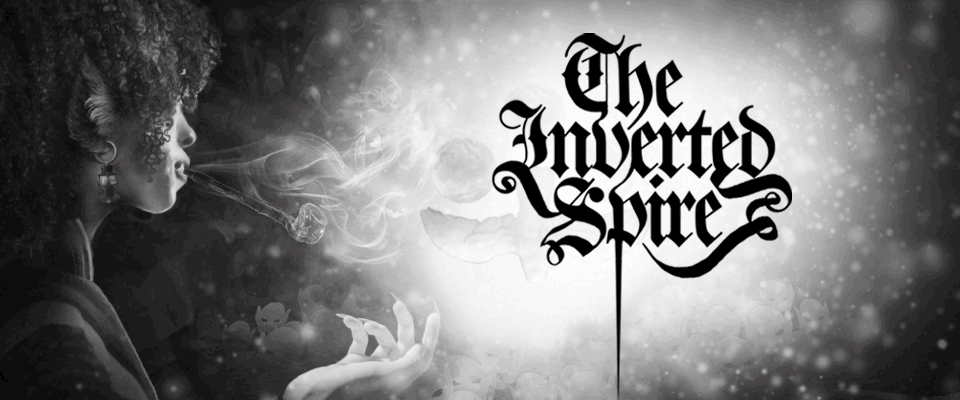
Comments
Log in with itch.io to leave a comment.
I wonder what Three's pipe looks like 👀
While I suspect Three, as a dedicated smoker, probably has multiple pipes in their possession—I'm happy to report that this is a question at least partially answered by the present version of the game!

A close-up from the screenshots: